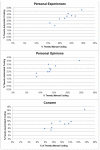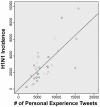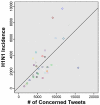Pandemics in the age of Twitter: content analysis of Tweets during the 2009 H1N1 outbreak
- PMID: 21124761
- PMCID: PMC2993925
- DOI: 10.1371/journal.pone.0014118
Pandemics in the age of Twitter: content analysis of Tweets during the 2009 H1N1 outbreak
Abstract
Background: Surveys are popular methods to measure public perceptions in emergencies but can be costly and time consuming. We suggest and evaluate a complementary "infoveillance" approach using Twitter during the 2009 H1N1 pandemic. Our study aimed to: 1) monitor the use of the terms "H1N1" versus "swine flu" over time; 2) conduct a content analysis of "tweets"; and 3) validate Twitter as a real-time content, sentiment, and public attention trend-tracking tool.
Methodology/principal findings: Between May 1 and December 31, 2009, we archived over 2 million Twitter posts containing keywords "swine flu," "swineflu," and/or "H1N1." using Infovigil, an infoveillance system. Tweets using "H1N1" increased from 8.8% to 40.5% (R(2) = .788; p<.001), indicating a gradual adoption of World Health Organization-recommended terminology. 5,395 tweets were randomly selected from 9 days, 4 weeks apart and coded using a tri-axial coding scheme. To track tweet content and to test the feasibility of automated coding, we created database queries for keywords and correlated these results with manual coding. Content analysis indicated resource-related posts were most commonly shared (52.6%). 4.5% of cases were identified as misinformation. News websites were the most popular sources (23.2%), while government and health agencies were linked only 1.5% of the time. 7/10 automated queries correlated with manual coding. Several Twitter activity peaks coincided with major news stories. Our results correlated well with H1N1 incidence data.
Conclusions: This study illustrates the potential of using social media to conduct "infodemiology" studies for public health. 2009 H1N1-related tweets were primarily used to disseminate information from credible sources, but were also a source of opinions and experiences. Tweets can be used for real-time content analysis and knowledge translation research, allowing health authorities to respond to public concerns.
Conflict of interest statement
Figures















References
-
- Picard A. Lessons of H1N1: Preach less, reveal more. 2010. Globe and Mail. Available: http://www.webcitation.org/5qYZly99e.
-
- Kasperson R, Renn O, Slovic P, Brown H, Emel J, et al. The social amplification of risk: a conceptual framework. Risk Analysis. 1988;8:177–187.
-
- Lau J, Griffiths S, Choi K, Tsui H. Widespread public misconception in the early phase of the H1N1 influenza epidemic. Journal of Infection. 2009;59:122–127. - PubMed
Publication types
MeSH terms
Grants and funding
LinkOut - more resources
Full Text Sources
Other Literature Sources
Medical

